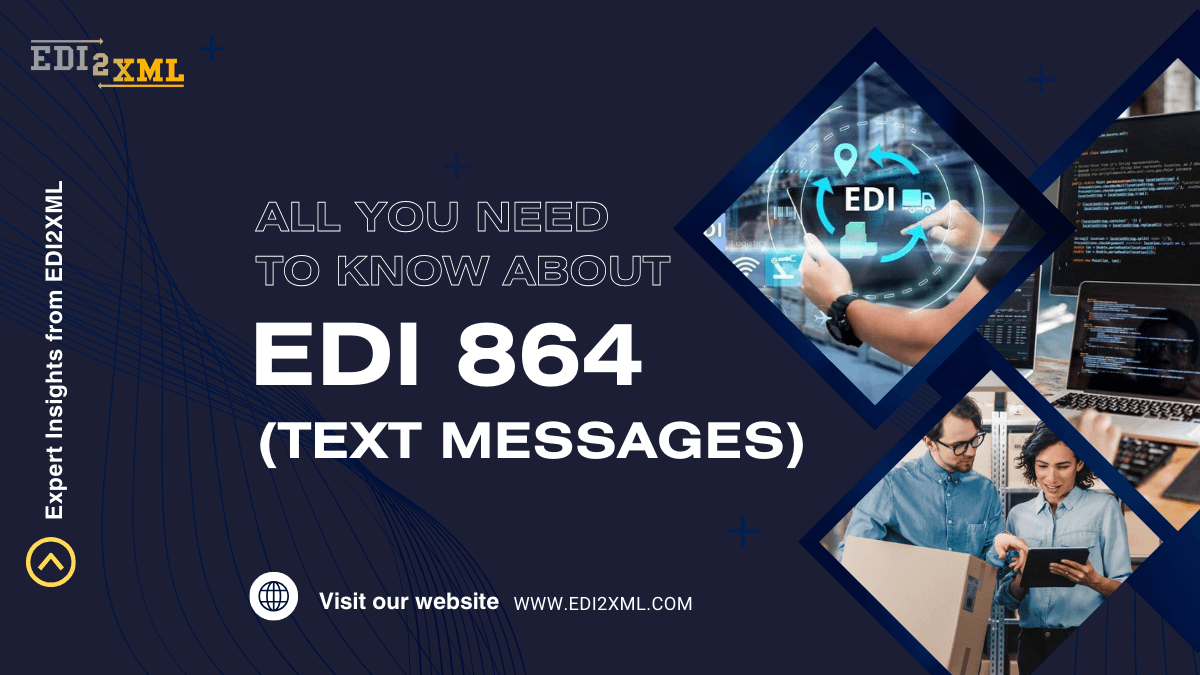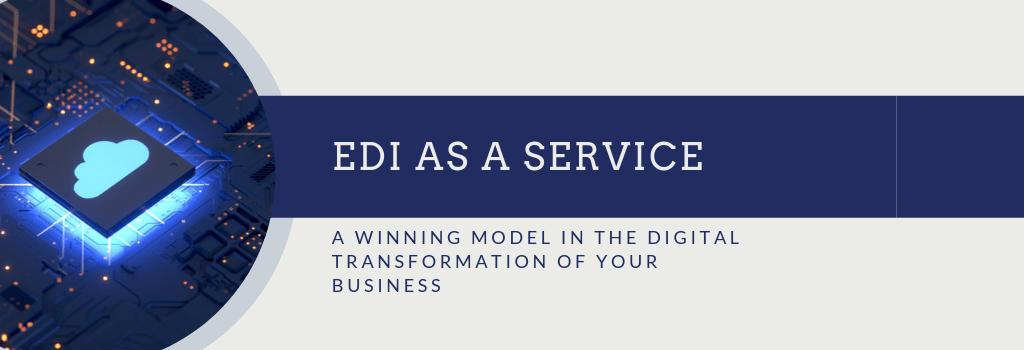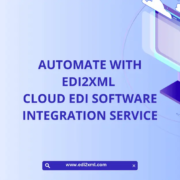All You Need to Know About EDI 864 Text Messages
Last Updated on September 3, 2024 by Tatyana Vandich
In this article, we’ll explore what EDI 864 is, its importance in B2B communication, common use cases, benefits, challenges, and why partnering with experienced EDI providers like EDI2XML is essential for successful EDI integration.
What is EDI 864 (Text Messages)?
The EDI 864 transaction, also known as Text Messages, is part of the Electronic Data Interchange (EDI) standard used in business-to-business communication. The EDI 864 transaction set is used for the exchange of various types of text messages between trading partners.
Unlike other EDI transactions designed for computer processing, the 864 is specifically crafted for transmitting various communications in a human-readable form.
These messages can include general information, errors, warnings, inquiries, acknowledgments, responses, and other types of textual communications related to business processes.
864 EDI Transaction: Purpose and Content
The primary purpose of the EDI 864 is to facilitate one-time communications between trading partners. This EDI document allows for the transmission of free-form text, which can include simple messages, contracts, explanations, and other human-readable content.
Rather than being structured for automated processing, the EDI 864 focuses on conveying information to people.
Document Components:
An EDI 864 document includes the following elements:
- Message date and time: Indicates when the message was sent.
- Recipient identifying information: Ensures proper delivery of the message.
- Free-form message text: The actual content of the communication.
While originally designed for one-time communications, some businesses have adopted it for regular updates (e.g., store or distribution center location information) when no other specific transaction set exists.

EDI 864 Format Example
To provide further clarity, we present below an illustrative example of an Electronic Data Interchange (EDI) 864 X12 transaction set. This example is intended to clarify the structure and components of an EDI 864 transaction, offering a tangible reference for understanding its implementation and functionality.
ISA*00* *00* *08*123485CA00 *08*5143737508 *230331*0004*:*00501*864000005*0*P*>
~GS*TX*123485CA00*5143737508*20230331*000400*864000005*X*005010
~ST*864*0001
~BMG*00*THESE DOCUMENTS WILL NOT BE PROCESSED.*03
~N1*FR*Wal-Mart Stores, Inc*UL*0681131000000
~N1*TO*New Manufacturing Inc.
~REF*IA*860515
~REF*IV*000000000682426
~MIT*PLEASE CORRECT AND RESEND.*THESE DOCUMENTS WILL NOT BE PROCESSED.*175*60
~MSG*SEGMENT ELEMENT ERROR*SS
~MSG*INVOICE NUMBER PO NUMBER ID POS – REF DATA COMMENTS*SS
~MSG*00682426 3400008253 TXI 001 – 603 0030063320000 INVALID TAX QUALIFIER PROD*SS
~SE*11*0001
~GE*1*864000005
~IEA*1*864000005~
EDI 864 Specification
Let’s break down this example of the EDI 864 file:
ISA segment:
ISA stands for Interchange Control Header. It specifies details such as sender ID, receiver ID, date, time, and control numbers.
– Sender ID: 123485CA00
– Receiver ID: 5143737508
– Date: 230331 (March 31, 2023)
– Control Numbers: 0004
GS segment:
The functional group header segment specifies the sender and receiver of the transaction, as well as the date and time.
– Functional Identifier Code (TX for text message)
– Application Sender’s Code (123485CA00)
– Application Receiver’s Code (5143737508)
– Date (20230331 for March 31, 2023)
– Time (000400 for 4:00 AM)
– Group Control Number (unique identifier)
– Responsible Agency Code (X for industry-specific code)
– Version/Release/Industry Identifier Code (005010)
ST segment:
The transaction set header segment indicates the start of a transaction set and provides identifying information.
– Transaction Set Identifier Code: 864
– Transaction Set Control Number: 0001
BMG segment:
This is a text message segment containing the message “THESE DOCUMENTS WILL NOT BE PROCESSED.” with a message code “00” and a text “03”.
N1 segments:
These segments provide information about the parties involved in the transaction.
– N1*FR: Sender (Wal-Mart Stores, Inc.)
– N1*TO: Receiver (New Manufacturing Inc.)
REF*IA: Invoice number reference (860515)
REF*IV: Invoice value reference (000000000682426)
MIT segment:
This is another text message segment containing the message “PLEASE CORRECT AND RESEND.” with additional details.
MSG Segments:
MSG stands for Message Text. Contains human-readable messages. Examples:
– “SEGMENT ELEMENT ERROR”
– “INVOICE NUMBER PO NUMBER ID POS – REF DATA COMMENTS”
– “00682426 3400008253 TXI 001 – 603 0030063320000 INVALID TAX QUALIFIER PROD”
SE segment:
The transaction set trailer segment indicates the end of a transaction set and provides control information.
– Number of Included Segments (11 in this case)
– Transaction Set Control Number (matches ST02)
GE segment:
The functional group trailer segment provides control information for the functional group.
– Number of Transaction Sets Included: 1
– Group Control Number: 864000005
IEA segment:
The interchange control trailer segment indicates the end of an interchange and provides control information.
– Number of Included Groups: 1
– Interchange Control Number: 864000005
Overall, this EDI 864 file contains a text message indicating that certain documents will not be processed and includes references, informational messages, and details about the parties involved in the transaction. Additionally, it highlights specific errors encountered during processing and provides instructions for correction and resending.

EDI 864 Example Scenarios
Here are some example scenarios illustrating the use of the EDI 864 transaction set:
Order Rejection Notification with EDI 864
Scenario: A retail company sends a purchase order (EDI 850) to a supplier. Upon reviewing the order, the supplier finds discrepancies or issues that prevent them from fulfilling the order.
Use of EDI 864: The supplier generates an EDI 864 transaction to inform the retail company about the rejection of the order. The 864 message may include details about the reasons for rejection, such as product availability, pricing discrepancies, or incorrect item information.
EDI 864 for Invoice Discrepancy Notification
Scenario: A manufacturer sends an invoice (EDI 810) to a distributor. However, upon receipt, the distributor identifies errors or discrepancies in the invoice.
Use of EDI 864: The distributor generates an EDI 864 transaction to notify the manufacturer about the invoice discrepancies. The 864 message may detail the specific issues found in the invoice, such as incorrect pricing, missing items, or incorrect quantities.
Error Notification in Shipping with EDI 864
Scenario: A logistics company sends shipping instructions (EDI 856) to a carrier. However, the carrier encounters issues during the shipment process.
Use of EDI 864: The carrier generates an EDI 864 transaction to notify the logistics company about the encountered errors. The 864 message may detail the issues faced during shipment, such as address discrepancies, delivery delays, or damaged goods.
In each of these scenarios, the EDI 864 transaction set plays a critical role in facilitating communication between trading partners, providing notification, acknowledgment, or resolution of issues encountered during various business processes.
What are the Benefits of EDI 864 Transaction Set?
Streamlined Communication: The EDI 864 streamlines the communication process, reducing the likelihood of errors associated with manual data entry.
Safe and Secure Communication: Like other EDI documents, the EDI 864 offers trading partners a safe and secure way to communicate with one another.
Efficiency: By automating the exchange of text messages related to business processes, EDI 864 helps streamline communication workflows. This can lead to faster resolution of issues, quicker decision-making, and overall improved efficiency in business operations.
Timeliness: EDI 864 enables real-time or near-real-time communication between trading partners, allowing them to promptly address issues, confirm receipt of messages, or provide updates on the status of transactions. This helps improve responsiveness and agility in business interactions.
Thus, the adoption of EDI 864 offers numerous benefits for businesses seeking to improve communication efficiency, reduce errors, enhance collaboration, and achieve cost savings in their electronic data interchange processes.
Delve into the realm of Electronic Data Interchange (EDI) through our illuminating video explanation. Discover the video.
Integration Challenges of EDI 864
The EDI 864 Text Message can be difficult to integrate and automate because it is a free-form text message designed for human readers. While the EDI 864 serves its purpose for human-readable communication, it is not optimized for machine processing. The absence of a predefined structure means that different organizations may use the EDI 864 in varying ways.
When it comes to implementing the EDI 864 and other EDI documents, partnering with an experienced EDI provider is crucial.
Conclusion: EDI 864 Text Messages for Business Communication
Integrating EDI 864 and other electronic data interchange (EDI) documents into your business processes can be challenging. From navigating complex validation rules to ensuring seamless integration with existing systems, there are numerous pitfalls that businesses may encounter along the way. That’s why it’s crucial to seek the expertise of an experienced EDI supplier like EDI2XML.
With over 24 years of experience in the field of EDI, we possess in-depth knowledge and understanding of the intricacies involved in EDI integration. Our team is well-equipped to handle the complexities of integrating EDI 864 and any other EDI document efficiently and effectively.
By partnering with us, businesses can benefit from our proven track record, streamlined processes, and personalized support, ensuring a smooth and successful EDI implementation tailored to their specific needs.
Book a free EDI consultation to discuss the challenges of EDI integration with our experts.










Leave a Reply
Want to join the discussion?Feel free to contribute!